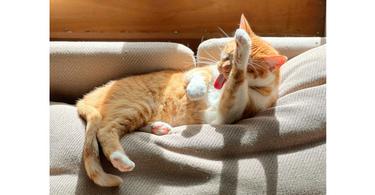As the days grow longer and temperatures rise, you might start noticing more tufts of fur around your home and on your clothes. That’s because spring and summer mark shedding season for many cats. But why do cats shed more during warmer months, and what does it mean for their health? Here’s what every cat parent should know.
Why do cats shed in spring and summer?
Shedding is a natural process that helps regulate your cat’s body temperature. As the weather warms up, cats begin to lose their thicker winter coat to make way for a lighter summer one. This seasonal shedding is most noticeable in cats who spend time near windows or outside, where their bodies respond to changing light levels and temperatures.
Indoor cats may shed more consistently year-round due to artificial lighting and stable indoor climates, but even they can experience a noticeable increase in hair loss during spring and summer.
Does increased shedding cause furballs?
Yes, it can. Cats are meticulous groomers, and when they shed more, they’re also likely to ingest more loose fur during grooming. This fur can accumulate in their stomach and form hairballs (technically called trichobezoars). Most of the time, cats manage to pass these through their digestive system or vomit them up, but frequent hairballs can be uncomfortable or even problematic.
Common signs of hairball trouble include:
-
Frequent retching without producing a hairball
-
Constipation or diarrhoea
-
Lack of appetite
-
Lethargy
If you notice any of these signs, it’s best to consult your vet.
How you can support your cat during shedding season
The good news is that you can help make shedding season easier on your cat and your hoover. Here’s how:
1. Brush your cat regularly
Grooming your cat at least a few times a week (daily for long-haired breeds) helps remove loose fur before they can swallow it. It also reduces shedding around the house and strengthens your bond with your cat.
Tip: Use a brush suited to your cat’s coat type. A rubber grooming mitt works well for short-haired cats, while long-haired breeds may benefit from a slicker brush or deshedding tool.
2. Feed a high-quality diet
Healthy fur starts from the inside. Diets rich in animal protein and omega-3 fatty acids (like those from salmon oil) can support skin and coat health, reducing excessive shedding and helping hairballs pass more easily.
3. Keep them hydrated
Hydration aids digestion and helps fur move through the digestive tract. Ensure your cat always has access to fresh water – some cats prefer running water, so consider a pet fountain.
4. Try hairball remedies
Hairball control pastes, specially formulated treats or high-fibre diets can help reduce hairball formation. Always choose products that are vet-recommended and suitable for your cat’s age and health.
5. Vacuum and clean frequently
Regular cleaning helps manage loose fur and allergens. A good handheld vacuum or lint roller can make light work of shedding season mess.
Final thoughts
Spring and summer shedding is completely normal, but it’s also a great opportunity to check in on your cat’s grooming routine, diet and overall wellbeing. With the right support, you can help your feline friend stay comfortable, healthy and (mostly) furball-free.

